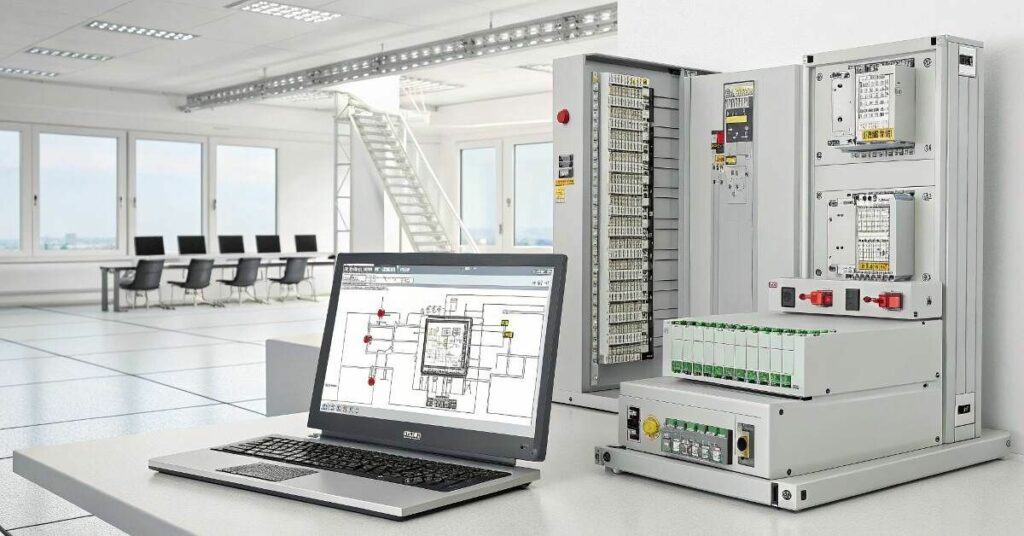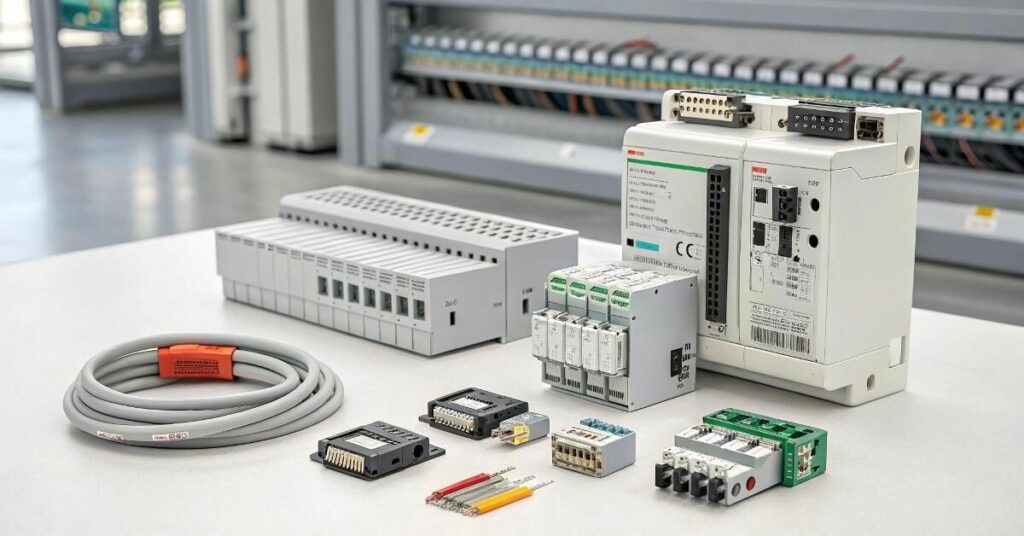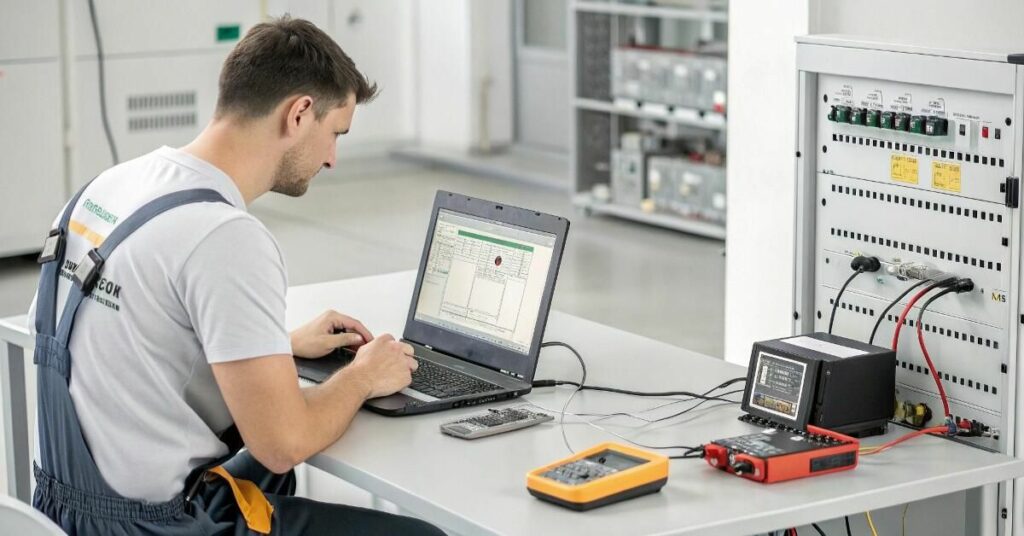PLC Programming Tools include more than just the software. Every programmer needs the right mix of hardware, software, and support to get the job done right. Without quality cables, a reliable laptop, and proper diagnostic tools, even the best code won’t run as expected.
There are certain tools that every PLC programmer should have. You should rely on a good programming software, have backup devices, and use simulation tools. Remember to have wire strippers, label printers, and a good multimeter, as they make life easier.
The right tools are essential for successful automation. They are useful for programming, as well as for making things more accurate, reducing waiting time, and easing troubleshooting. With the right equipment, automation processes run smoothly, efficiently, and with fewer issues.
Understanding the Basics of PLC Programming

PLCs control machines by reading inputs and sending out the right outputs. Sensors, switches, and other devices send signals to the PLC. After receiving the signals, the PLC determines what action to take. Making quick decisions is what allows automated systems to function properly. Whether it’s turning on a motor or stopping a conveyor, the PLC handles it with precision.
Programming tools turn ideas into working machine commands. These tools make the job faster, easier, and far less stressful. They help build logic, test functions, and find errors before they cause trouble. With the right software and interface, you can program confidently and fix issues in no time.
Core Hardware Tools Every PLC Setup Needs

A solid PLC setup starts with strong core components. The PLC unit, power supply, and I/O modules are the real foundation. They handle information, provide power for the system, and connect all of its components. The process cannot work if they are not present. That’s the main reason why it’s important to pick high-quality hardware early on.
Effective programming and solving problems depend on good communication. I believe using the correct cables and adapters is what really counts. These products make it easy for your PC to communicate with the PLC.
The following essentials should always be on hand:
- USB-to-serial adapters
- Ethernet cables
- RS-232 or RS-485 connectors
- Backup cables for different PLC brands
- Cable testers to check for faults
Must-Have Software Tools for Programming and Simulation
Any PLC system relies heavily on programming software. I believe using Ladder Logic and Function Block Diagram helps produce programs that are easy to understand and dependable. It is simple to construct, arrange and understand logic in these environments. Using these tools, you can run motors or set up alarms in an organized and fast manner.
Software for simulations is also vital. It enables you to check your ideas without using any machinery. As a result, you’ll make fewer mistakes, work more efficiently and trust in what you do.
Here’s a quick look at useful software tools:
| Tool Type | Purpose | Example Software |
| Programming Environment | Build and edit PLC logic | TIA Portal, RSLogix 500 |
| Simulation Tool | Test logic without physical hardware | Factory I/O, PLC Simulator |
| Debugging Tool | Find and fix logic errors | Codesys, Logix Designer |
Diagnostic and Monitoring Accessories

Fast troubleshooting starts with the right diagnostic tools. The use of handheld testers and multimeters is essential. They quickly spot wiring faults, broken connections, or weak signals. This saves time and avoids guesswork. A few quick tests can prevent major delays on the floor.
HMI panels have the same level of importance as other panels. The operators are provided with a live view of the situation. You can quickly check the inputs, outputs and condition of the system. Besides, you can use the HMI to make changes quickly and simply. It allows everything to work fine without needing to bring a laptop everywhere.
Communication and Interface Devices
Automation systems can only work well when communication is smooth. They are key components in connecting devices in the industrial world. It is simple for them to connect PLCs to networks, HMIs and other devices. From what I see, if these tools are missing, data sharing is interrupted and everything slows down. If your link is strong, the response will be quicker and control will be better.
Integrating more deeply into the network depends on using protocol tools. OPC servers are used to enable various systems to share information. Data may be transferred from PLCs, SCADAs, and MES platforms using these devices. The result is that automated systems become more aware and linked with other devices. Better communication helps people perform better.
Maintenance and Safety Essentials
Up time is important and proper protection ensures it stays that way. When there is no main power, backup batteries save your important files. They protect the equipment by keeping dust, heat and moisture away. They prevent sudden power surges from damaging your computer. In the long run, using these tools reduces both trouble and costs.
Safety should never be an afterthought. Lockout/tagout kits stop machines from starting during repairs. Insulated tools protect against shocks and short circuits. I feel these items are non-negotiable for safe work. They help teams stay protected while keeping the system in top shape.
FAQ’s
What are the essential PLC Programming Tools for beginners?
Some basic tools for this are a PLC unit, software for programming, simulation tools and dependable connection cables.
Do I need both hardware and software tools for PLC projects?
Both hardware and software are important—the system depends on the hardware which is programmed using software.
What safety accessories should I use when working with PLCs?
Ensure your safety by using insulated tools, lockout/tagout kits and surge protection.
Conclusion
It is very important to have the right tools and accessories for a PLC. Any system depends on both hardware and software. If every part of automation is properly synchronized, it functions more quickly, safely and reliably.
Purchasing high-quality tools helps you save time and avoid expensive breaks. Communication, appropriate gear and testing tools help make each job less complicated. The proper setup will help your business succeed in the long run.

